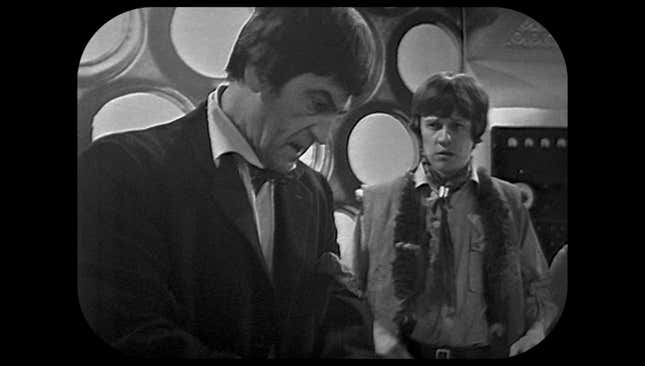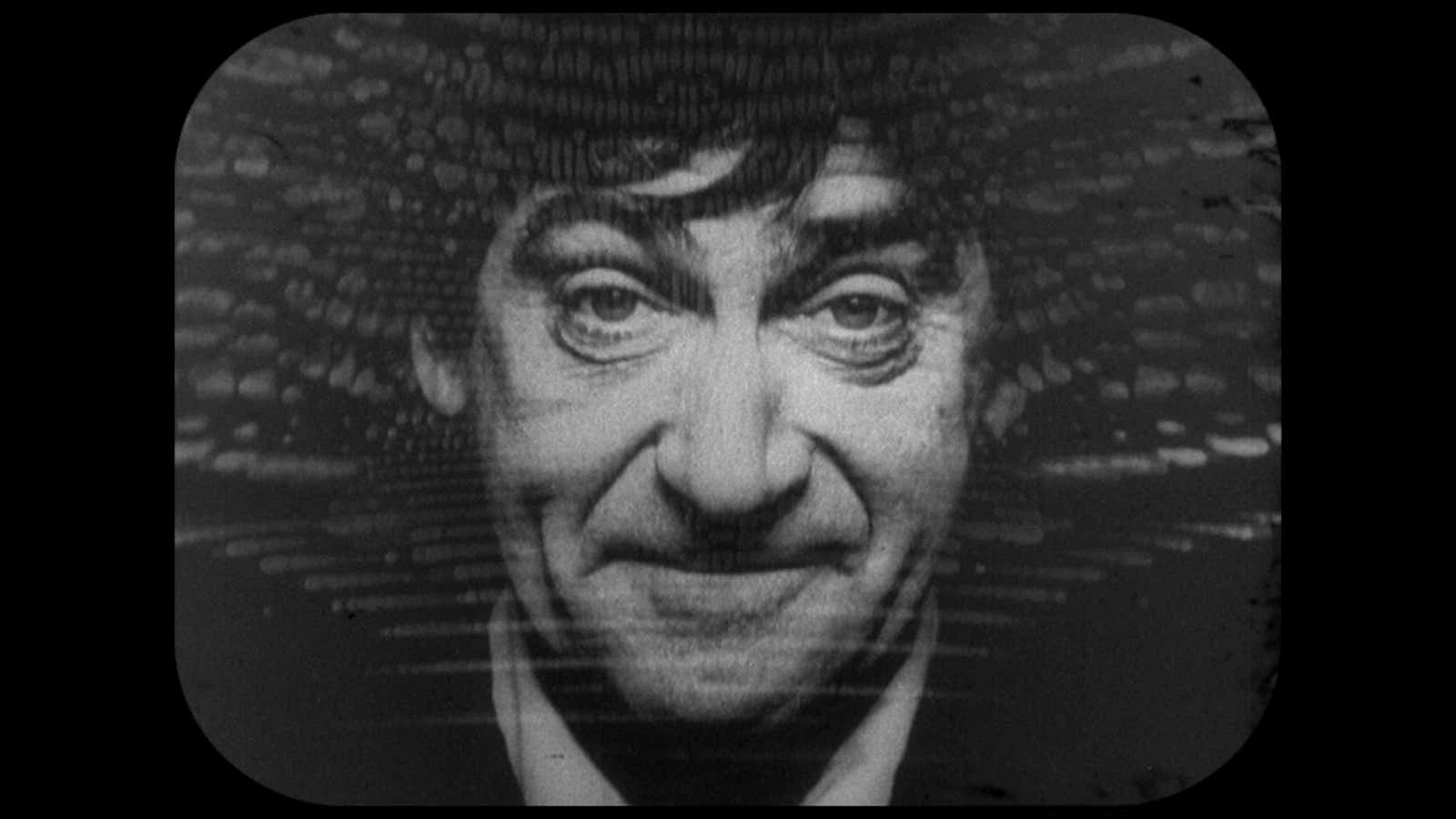Fans of Doctor Who, the BBC’s time-traveling adventure TV series, are like no other.
After 54 years, 36 seasons, 839 episodes, and 12 different Doctors (the thirteenth will be the first played by a woman), they’re still one of the most passionate pop-culture fanbases out there. And a small group of the diehard Whovians, as Doctor Who fans are fondly known, are working with the BBC to restore episodes of the show that have been lost for generations.
Some of the newly recovered episodes have been released on DVD along with the classic episodes of Doctor Who that aired from 1963-1989. The latest to be restored, a six-part story from the time of the Second Doctor, Patrick Troughton, called “The Wheel in Space,” hits the streaming service BritBox beginning in September.
BritBox is a joint subscription-video venture between BBC Worldwide and fellow British broadcaster ITV that brings UK TV to US audiences. The $6.99-a-month platform is the exclusive US streaming home of classic Doctor Who. And its endeavoring to collect as many of the missing episodes as possible; many of the negatives and distribution prints of old episodes that were returned by foreign broadcasters were destroyed around 1975—because interest in the show had waned and the company didn’t see any reason to keep them.
Fifty classic Doctor Who episodes have been recovered so far, BritBox told Quartz. And another 97 of the 253 episodes from the show’s first six years on the air are still missing, though short clips of some do exist.
“We wanted to make a comprehensive home for it,” Soumya Sriraman, president of BritBox, told Quartz. “Knowing that there were several of these episodes that were never recreated… we thought we should at least offer that for our fans.”
Episodes lost in time
Tracking some of the missing episodes hasn’t been the easiest thing. Before the 1970s, TV was disposable. Programs were recorded on videotapes, and, from the late 1960s until 1974, BBC Enterprises, as its commercial arm BBC Worldwide was then known, transferred the tapes to 16mm prints to distribute as sales copies around the world. Original negatives of the episodes were also made.
Once the UK transmission of the episodes had gone out, and the overseas sales copies had been created, the original videotapes were erased and re-used. There was no home-video, DVD, download, or streaming market for the shows at the time, so there was no real reason for the BBC to keep the tapes after they were done with them. Audiences couldn’t stream endless archives of TV shows like they can today through Hulu, Amazon, or Netflix. If an episode was gone, it was really gone.
Unless someone made a real effort to find them.
More than thirty years ago, when film producer and director Paul Vanezis was a 19-year-old Doctor Who fan, he’d heard there were quite a few episodes from the 1960s and 1970s that were lost by the British broadcaster after they aired. Vanezis also heard that foreign broadcast stations might still have copies from when they aired the show. There was no record of where Doctor Who had been screened around the world then, he said.
So the industrious young Whovian then took it upon himself to write the Cyprus Broadcasting Corporation (CBC) in 1984 to see whether the station had ever screened Doctor Who, and, if it did, whether it had kept any copies.
Vanezis is English, but his father was a Greek from Cyprus, so he figured “they would be more likely to reply to me when they see my Greek surname,” he told Quartz. The station wrote back and confirmed that it did indeed screen Doctor Who and still had 16mm film prints of 13 episodes in its possession. Three of those were the only known copies in existence at the time, and two still are. The other episodes screened by the station had been destroyed in a Turkish invasion in 1974, Vanezis said.
Vanezis was eager to get his hands on the episodes—but the BBC was on a mission of its own. Shortly after Vanezis contacted the CBC, the BBC sent telexes to foreign TV stations asking them to return any copies of old episodes of Doctor Who that they had retained. The CBC was one of two or three who responded, Vanezis said, and all 13 episodes were returned the following year. Today, Vanezis works as a freelancer with the BBC to track down and restore the broadcaster’s missing archives, including the lost episodes of Doctor Who, as part of a small team of mostly fellow Whovians.
One of the last batches of episodes to be recovered was in 2013, when nine episodes were returned to the BBC, Vanezis said. “It’s kind of remarkable that these things are out there and still being found,” he said.
Throw-away TV
This hasn’t just been a problem for the BBC. In the US, episodes from Johnny Carson’s early years hosting NBC’s The Today Show were lost—and some are still missing today. The same is true for episodes of other US TV series like the original Jeopardy! and soap operas like Guiding Light. In 1978, the BBC established a TV archive and began recollecting that lost footage with the help of archivists, fans, film collectors, and TV stations as far and wide as Cyprus, Nigeria, Hong Kong, and Australia.
In 1989, after classic Doctor Who went off the air, a small group of UK fans kept the show alive by holding watch parties and working on the shows. Some of those fans were in touch with the BBC about ways to restore old episodes and the BBC hired them. ”They started as diehard fans, some of whom worked in TV as well as being fans so they had a technical expertise, and the BBC hired these people to be the Doctor Who restoration team,” according to BBC Worldwide.
In the 1990s, the group began by restoring old copies of episodes that originally aired in color, starting in the 1970s, but only survived in black and white. Vanezis, who had a background working with film, worked with the team to use poor-quality off-air recordings that were made by broadcasters in Chicago and Los Angeles to re-colorize the high-quality black-and-white masters that the BBC had.
“The programs we were trying to restore weren’t technically lost programs,” he said. “They still existed, they just didn’t exist in the original form they were made. What I was really interested in was trying to fill the gaps in the archive.”
That’s what he and the team did. In some cases, it was a matter of processing the 16mm prints—repairing damage to the film, holes where commercials may have been inserted, or where the show may have been censored—and then scanning it in high definition, and using digital software to manually clean up each frame.
In one instance, where two episodes were recovered from a film collector in the south of England in 2011, the team found that parts of the episode had been removed, including a scene where the Doctor’s companion was going to be injected with a hypodermic needle. The sections that had been removed seemed to match exactly with Australian government censorship rules at the time, Vanezis said. They were able to obtain the missing pieces from Australia’s national archives, and piece the episodes back together.
The Wheel in Space
The latest Doctor Who story to be restored, “The Wheel in Space,” was reconstructed by members of the restoration team who worked with BritBox. It was told through six episodes, which aired from April to June 1968.
In this case, only audio tapes that were recorded by devoted fans off their TV sets were recovered, BritBox said. It paired those with telesnaps, or pictures of the TV that were taken by the BBC for archival purposes back in the 1960s. There were a few shots of every scene and every action. Mark Ayres, a sound engineer restored the audio, and John Kelly, formerly of the Doctor Who restoration team, paired it with visuals from the telesnaps, as well as surviving publicity photos, and stills taking from surviving video clips.

“The most challenging part of the recon is keeping the visuals moving at a suitable pace; both sympathetic to the episode as it would have been on transmission (I reference the original camera script), yet maintaining enough dynamic to engage a modern audience,” Kelly told Quartz via email. “To this end, a lot of extra material has to be sourced from other contemporaneous episodes, or through stills taken during recording, or as montages created through various means.”
A production group called the Loose Canon provided montages and CGI renderings that Kelly incorporated into the project, he said. A sneak peak of the first episode in the story is being shown at San Diego Comic-Con today before its September release on BritBox. Since the panel was announced, fans have been speculating on Reddit and blogs about what’s to come from the episodes, and what other clips are out there.
“This is a very unique situation,” said Sriraman at BritBox. “I don’t know of any other TV show in the history of TV where fans actively come in and do this and mobilize around finding clips and sending them to the folks they think need to see it.”
